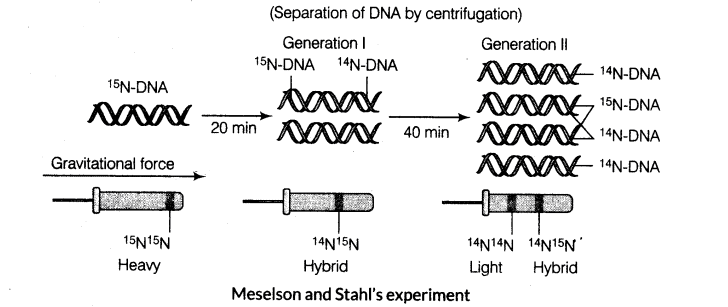Genetic Material | Biology for ACT PDF Download
DNA is the Genetic Material
(i) Alfred Hershey and Martha Chase (1952) gave unequivocal proof that DNA is the genetic material.
(ii) In their experiments, bacteriophages (viruses that infect bacteria) were used.
(iii) They grew some viruses on a medium that contained radioactive phosphorus and some others on sulphur containing radioactive medium.
(iv) Viruses grown in the presence of radioactive phosphorus contained radioactive DNA but not radioactive protein because DNA contains phosphorus but protein does not. In the same way, viruses grown on radioactive sulphur contained radioactive protein, but not radioactive DNA because DNA does not contain sulphur.

(v) Radioactive phages were allowed to attach to E. coli bacteria. As the infection proceeded, viral coats were removed from the bacteria by agitating them in a blender. The virus particles were separated from the bacteria by spinning them in a centrifuge.
(vi) Bacteria which were infected with viruses that had radioactive DNA were radioactive, indicating that DNA was the material that passed from the virus to the bacteria.
(vii) Bacteria that were infected with viruses that had radioactive proteins were not radioactive. This indicated that the proteins did not enter the bacteria from viruses. It proved that DNA is a genetic material that is passed from virus to bacteria.
Properties of Genetic Material
(i) It became establised that DNA is the genetic material from the Hershey-Chase experiment.
(ii) In some viruses, RNA was also reported as genetic material, e.g. Tobacco mosaic viruses, QB bacteriophage, etc.
(iii) Characteristics of a Genetic Material
(a) It should be able to replicate.
(b) It should be chemically and structurally stable.
(c) It should provide scope for slow changes (mutation) that are required for evolution.
(d) It should be able to express itself in the form of ‘Mendelian characters’.
(iv) According to the above mentioned rules, both the nucleic acids (DNA and RNA) have the ability to direct duplications.
Stability can be explained in DNA as the two strands being complementary if separated by heating come together in appropriate conditions.
(v) The 2′ — OH group present at every nucleotide in RNA is a reactive group and makes RNA labile and easily degradable, hence it is reactive.
(vi) DNA is chemically less reactive and structurally more stable when compared to RNA. Thymine also confers additional stability to DNA. So, among the two nucleic acids, the DNA is a predominant genetic material.
(vii) Both RNA and DNA are able to mutate. Viruses having RNA genome and having shorter life span mutate and evolve faster.
(viii) DNA is dependent on RNA for protein synthesis, while RNA can directly code for it. The protein synthesizing machinery has evolved around RNA. This concluded that the DNA being more stable is suitable for storage of genetic information, while for the transmission of genetic information, RNA is suitable.
Francis Crick proposed the central dogma in molecular biology, which states that the genetic information flows from
Replication Scheme for replication of DNA termed as semi-conservative DNA replication was proposed by Watson and Crick (1953).
According to it:
(i) The two strands would separate and act as a template for the synthesis of new complementary strands. .
(ii) After replication, each DNA molecule would have one parental and one newly synthesised strand.
Experimental proof that DNA replicates semi-conservatively, comes first from E. coli and later from higher organisms, such as plants and human cells.
Matthew Meselson and Franklin Stahl Experiment
They performed the following experiments to prove this in 1958.
(i) E. coli was grown in a medium containing 15NH4Cl as the only nitrogen source for many generations. 15N got incorporated into newly synthesised DNA (and other nitrogen containing compounds). This heavy DNA molecule could be distinguished from the normal DNA by centrifugation in a cesium chloride (CsCl) density gradient.
(ii) They then transferred the cells into a medium with normal 14NH4Cl and took samples at various definite intervals as the cells multiplied and extracted the DNA that remained as double stranded helices. DNA samples were separated independently on CsCl gradients to measure DNA densities.
(iii) The DNA that was extracted from the culture, one generation (after 20 min) after the transfer from 15N to 14N medium had a hybrid or intermediate density. DNA extracted from the culture after another generation (after 40 min) was composed of equal amounts of this hybrid DNA and of light DNA.
(iv) Very similar experiments were carried out by Taylor and Colleagues on Vicia faba (faba beans) using radioactive thymidine and the same results, i.e. DNA replicates semi-conservatively, were obtained as in earlier experiments.
|
226 videos|247 docs|150 tests
|
FAQs on Genetic Material - Biology for ACT
| 1. What is genetic material? |  |
| 2. How is genetic material inherited? |  |
| 3. What are the functions of genetic material? |  |
| 4. Can genetic material be altered or mutated? |  |
| 5. How is genetic material studied? |  |





















